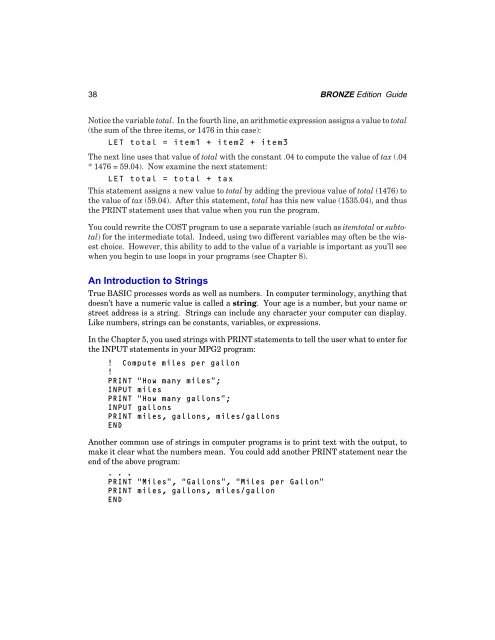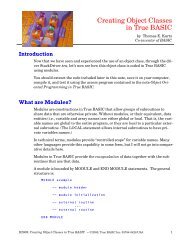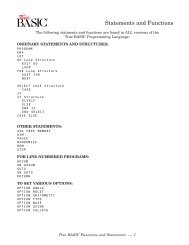Bronze Edition Guide - True BASIC
Bronze Edition Guide - True BASIC
Bronze Edition Guide - True BASIC
Create successful ePaper yourself
Turn your PDF publications into a flip-book with our unique Google optimized e-Paper software.
38 BRONZE <strong>Edition</strong> <strong>Guide</strong><br />
Notice the variable total. In the fourth line, an arithmetic expression assigns a value to total<br />
(the sum of the three items, or 1476 in this case):<br />
LET total = item1 + item2 + item3<br />
The next line uses that value of total with the constant .04 to compute the value of tax (.04<br />
* 1476 = 59.04). Now examine the next statement:<br />
LET total = total + tax<br />
This statement assigns a new value to total by adding the previous value of total (1476) to<br />
the value of tax (59.04). After this statement, total has this new value (1535.04), and thus<br />
the PRINT statement uses that value when you run the program.<br />
You could rewrite the COST program to use a separate variable (such as itemtotal or subtotal)<br />
for the intermediate total. Indeed, using two different variables may often be the wisest<br />
choice. However, this ability to add to the value of a variable is important as you’ll see<br />
when you begin to use loops in your programs (see Chapter 8).<br />
An Introduction to Strings<br />
<strong>True</strong> <strong>BASIC</strong> processes words as well as numbers. In computer terminology, anything that<br />
doesn’t have a numeric value is called a string. Your age is a number, but your name or<br />
street address is a string. Strings can include any character your computer can display.<br />
Like numbers, strings can be constants, variables, or expressions.<br />
In the Chapter 5, you used strings with PRINT statements to tell the user what to enter for<br />
the INPUT statements in your MPG2 program:<br />
! Compute miles per gallon<br />
!<br />
PRINT “How many miles”;<br />
INPUT miles<br />
PRINT “How many gallons”;<br />
INPUT gallons<br />
PRINT miles, gallons, miles/gallons<br />
END<br />
Another common use of strings in computer programs is to print text with the output, to<br />
make it clear what the numbers mean. You could add another PRINT statement near the<br />
end of the above program:<br />
. . .<br />
PRINT “Miles”, “Gallons”, “Miles per Gallon”<br />
PRINT miles, gallons, miles/gallon<br />
END









